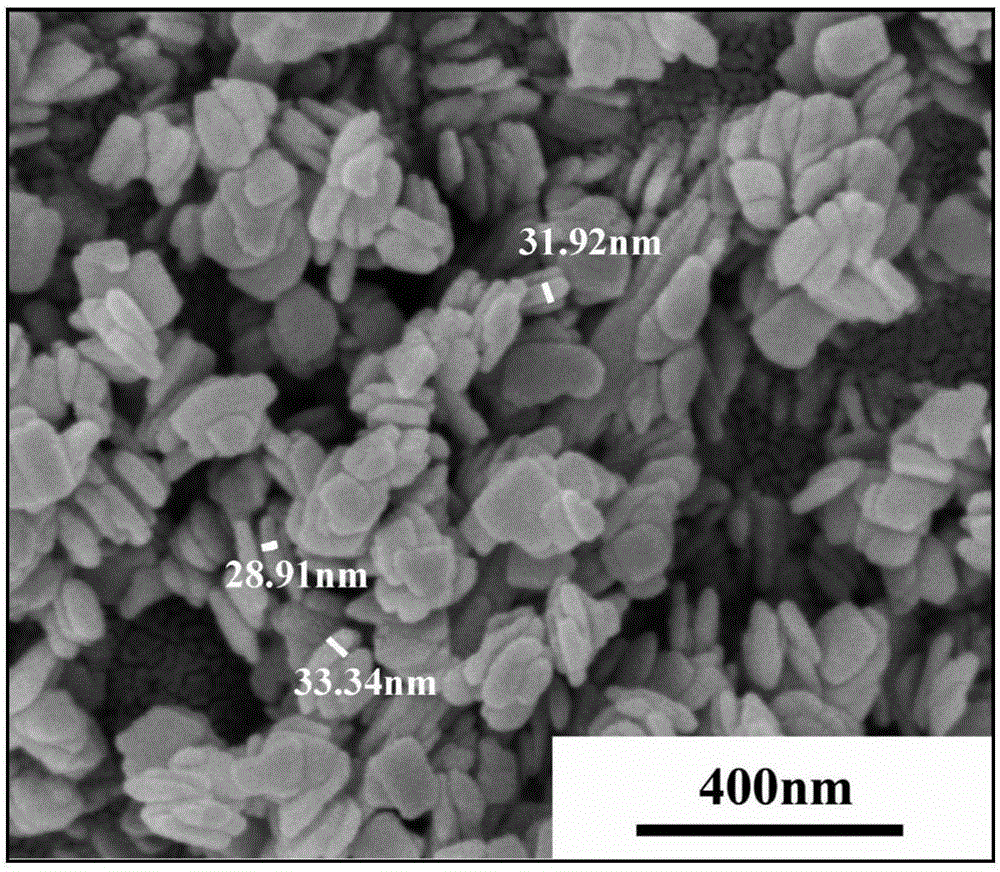Preparation method and application of b-axial LiFePO<4>/C nano flake material
A nano-flaky, axial technology, applied in the electrical field, can solve the problems of poor rate performance of lithium batteries, and achieve the effect of good lithium extraction/insertion ability and uniform grain size.
- Summary
- Abstract
- Description
- Claims
- Application Information
AI Technical Summary
Problems solved by technology
Method used
Image
Examples
Embodiment 1
[0034]Take 40.5mmol of LiOH.H 2 O was dissolved in 40 ml of ethylene glycol and magnetically stirred. After the solution was dissolved, 22.5 mmol of concentrated phosphoric acid solution was slowly added dropwise while stirring, and a white suspension could be seen. Take 15mmol of FeSO 4 .7H 2 A certain amount of ascorbic acid (FeSO 4 .7H 2 5% wt of O) was completely dissolved in 40 ml of ethylene glycol, then added to the above white suspension while stirring, and stirring was continued for 30 minutes. FeSO 4 .7H 2 O:H 3 PO 4 :LiOH·H 2 O:ethylene glycol was used as a reactant and the molar ratio was 1:1.5:2.7:1.43. The suspension was moved to a closed reaction kettle with a polytetrafluoroethylene lining. The filling degree of the autoclave was 75%. The reaction kettle was placed in a constant temperature blast drying oven, heated to 180 °C for 10 hours, and then cooled to room temperature. . The resulting gray-green precipitate was then washed repeatedly with deio...
Embodiment 2
[0036] Take 40.5mmol of LiOH.H 2 O was dissolved in 65 ml of ethylene glycol and magnetically stirred. After the solution was dissolved, 22.5 mmol of concentrated phosphoric acid solution was slowly added dropwise while stirring, and a white suspended matter could be seen. Take 15mmol of FeSO 4 .7H 2 A certain amount of ascorbic acid (FeSO 4 .7H 2 5% wt of O) was completely dissolved in 65 ml of ethylene glycol, then added to the above white suspension with stirring, and stirring was continued for 45 minutes. FeSO 4 .7H 2 O:H 3 PO 4 :LiOH·H 2 O:ethylene glycol was used as a reactant and the molar ratio was 1:1.5:2.7:2.32. The suspension was moved to a closed reaction kettle with a polytetrafluoroethylene lining. The filling degree of the autoclave was 75%. The reaction kettle was placed in a constant temperature blast drying oven, heated to 180 °C for 10 hours, and then cooled to room temperature. . The resulting gray-green precipitate was then washed repeatedly wit...
Embodiment 3
[0038] Take 40.5mmol of LiOH.H 2 O was dissolved in 80 ml of ethylene glycol and magnetically stirred. After the solution was dissolved, 22.5 mmol of concentrated phosphoric acid solution was slowly added dropwise while stirring, and a white suspended matter could be seen. Take 15mmol of FeSO 4 .7H 2 A certain amount of ascorbic acid (FeSO 4 .7H 2 5% wt of O) was completely dissolved in 80 ml of ethylene glycol, then added to the above white suspension while stirring, and stirring was continued for 60 minutes. FeSO 4 .7H 2 O:H 3 PO 4 :LiOH·H 2 O:ethylene glycol was used as a reactant and the molar ratio was 1:1.5:2.7:2.86. The suspension was moved to a closed reaction kettle with a polytetrafluoroethylene lining. The filling degree of the autoclave was 75%. The reaction kettle was placed in a constant temperature blast drying oven, heated to 180 °C for 10 hours, and then cooled to room temperature. . The resulting gray-green precipitate was then washed repeatedly wi...
PUM
| Property | Measurement | Unit |
|---|---|---|
| thickness | aaaaa | aaaaa |
| thickness | aaaaa | aaaaa |
Abstract
Description
Claims
Application Information
 Login to View More
Login to View More - R&D
- Intellectual Property
- Life Sciences
- Materials
- Tech Scout
- Unparalleled Data Quality
- Higher Quality Content
- 60% Fewer Hallucinations
Browse by: Latest US Patents, China's latest patents, Technical Efficacy Thesaurus, Application Domain, Technology Topic, Popular Technical Reports.
© 2025 PatSnap. All rights reserved.Legal|Privacy policy|Modern Slavery Act Transparency Statement|Sitemap|About US| Contact US: help@patsnap.com



